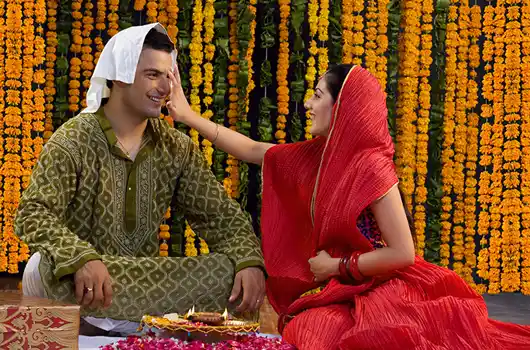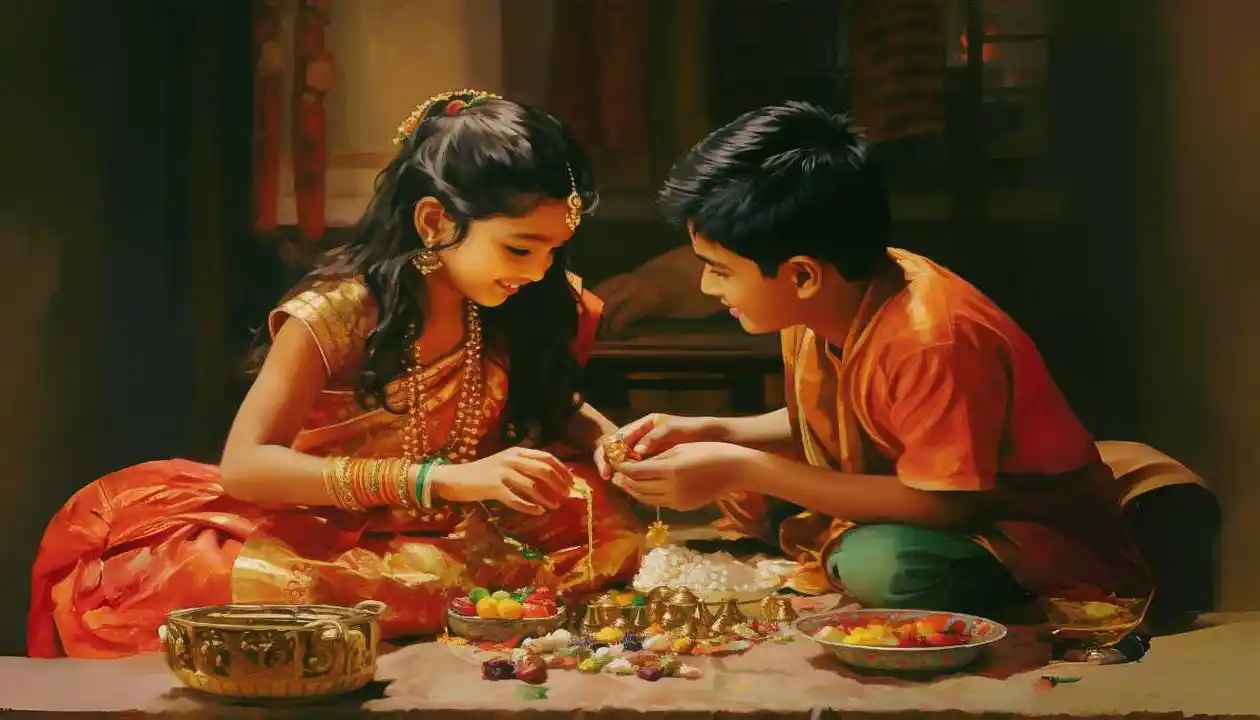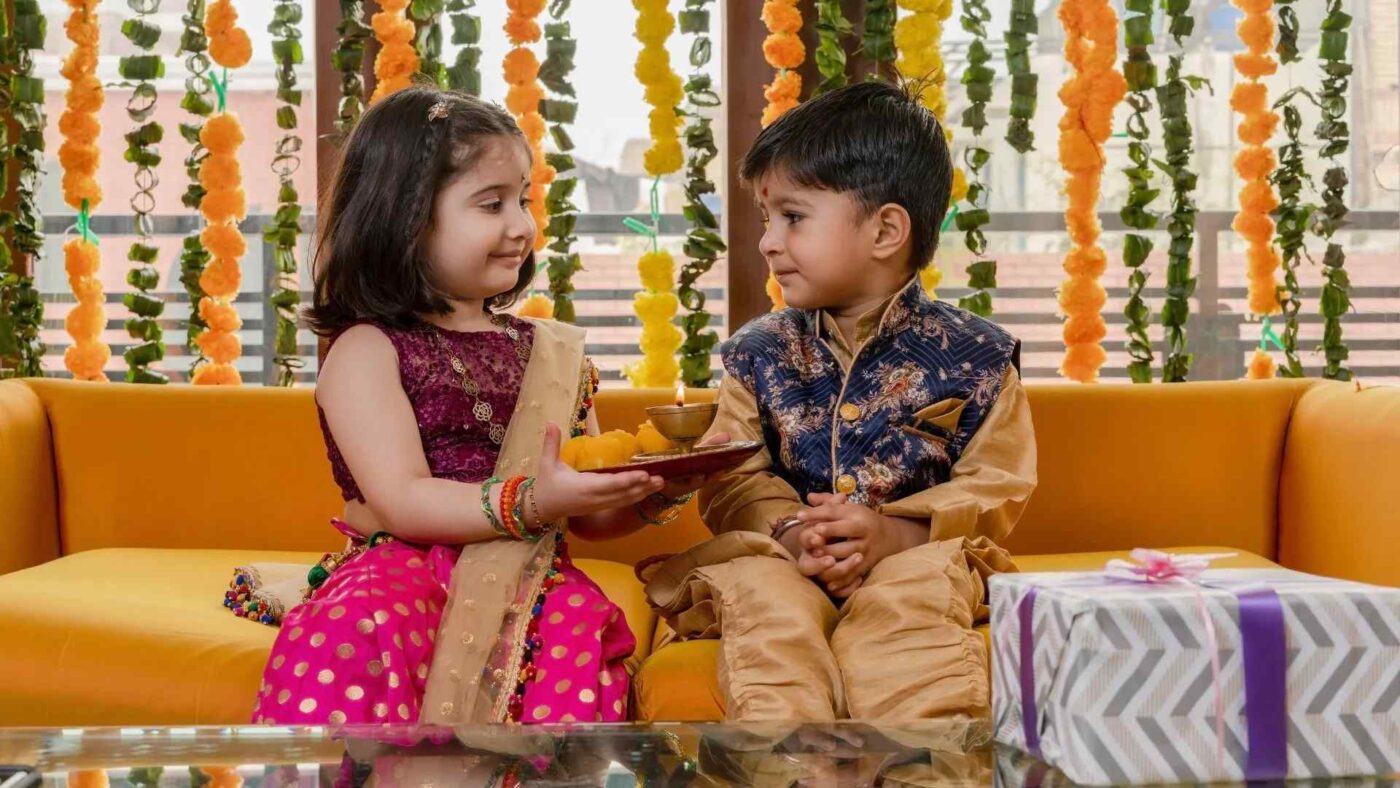India is a land of vibrant festivals, rich traditions, and enduring customs, with each festival deeply rooted in the cultural fabric of its diverse regions. Among these, Bhai Dooj (also known as Bhaiya Dooj, Bhau Beej, or Bhai Tika in Nepal) stands out as a celebration of the sacred bond between brothers and sisters. Held on the second day of the lunar month of Kartik, just after the festival of Diwali, Bhai Dooj is a festival filled with warmth, love, and reverence.
Much like Raksha Bandhan, Bhai Dooj is centered around the theme of sibling love. However, it carries its own unique set of rituals and significance. This article delves deep into the history, significance, cultural variations, and modern-day relevance of Bhai Dooj, bringing to light the beauty of this timeless festival that strengthens the bond between brothers and sisters.
bhai Dooj in West Bengal Called is Bhai Phonta (or Bhai Phota). It is a similar celebration to Bhai Dooj in other parts of India, where sisters pray for their brothers’ well-being and apply a ceremonial “phonta” (mark) of sandalwood paste or vermillion on their brothers’ foreheads. The festival is celebrated with rituals, traditional Bengali food, and gifts exchanged between siblings.
Origins and Mythological Background
Bhai Dooj meaning
The origins of Bhai Dooj are intertwined with Hindu mythology, where stories from ancient scriptures provide insights into the festival’s importance. One of the most well-known legends associated with Bhai Dooj revolves around the bond between Yamraj, the God of Death, and his sister Yamuna, the river goddess.
According to the legend, Yamuna longed for her brother Yamraj to visit her, but due to his duties in the underworld, he was unable to fulfill her request. Finally, on Dwitiya (the second day of the waxing moon in Kartik), Yamraj visited his sister. Overjoyed by his presence, Yamuna performed a special aarti for him, applied the auspicious tilak on his forehead, and prepared a grand feast. Touched by his sister’s love, Yamraj granted her a boon: every year on this day, any brother who visits his sister and receives her blessings would be protected from untimely death.
This legend symbolizes the deep bond between siblings and highlights the protective aspect of the brother-sister relationship. It also underlines the role of sisters in praying for their brothers’ longevity, well-being, and success. Over the years, this story became the foundation of Bhai Dooj, a festival where sisters pray for their brothers, and brothers, in turn, vow to protect their sisters.
Another popular mythological association is with Lord Krishna and his sister Subhadra. After slaying the demon Narakasura, Lord Krishna visited Subhadra, who welcomed him with aarti, tilak, sweets, and flowers, expressing her love and blessings for her brother. This event is often considered one of the reasons why Bhai Dooj is celebrated with great enthusiasm.

Rituals and Celebrations
Bhai Dooj is marked by a series of rituals that focus on the bond between brothers and sisters. While the customs may vary slightly from region to region, the essence remains the same. Here’s a closer look at the traditional rituals of Bhai Dooj:
1. Tilak Ceremony
The central ritual of Bhai Dooj involves the sister applying a tilak (a mark made with vermillion or sandalwood paste) on her brother’s forehead. The tilak is symbolic of the sister’s prayers for her brother’s long life and prosperity. The rice grains that accompany the tilak represent abundance, while the act itself is seen as a blessing that wards off evil spirits and ensures protection.
2. Aarti and Prayers
After applying the tilak, the sister performs an aarti for her brother, waving a small lamp (diya) in front of him in a circular motion. This act signifies the sister’s prayers for her brother’s well-being and the removal of any obstacles in his life. It is accompanied by prayers and blessings for his safety, health, and happiness.
3. Sweets and Feast
Sweets play a significant role in Indian festivals, and Bhai Dooj is no exception. After the tilak ceremony, sisters offer their brothers sweets, signifying the sweetness of their relationship and the shared joy of the occasion. Brothers, in turn, present their sisters with gifts or tokens of appreciation.
Traditional sweets such as laddoos, kheer, barfi, and halwa are commonly prepared, along with a feast that is shared by the entire family. This meal is not just about eating together but also about strengthening familial bonds through shared experiences.
4. Gift Exchange
As with many festivals, the exchange of gifts is an important aspect of Bhai Dooj. Brothers give their sisters gifts as a token of love, ranging from clothes, jewelry, and sweets to more modern items like gadgets, books, or money. Sisters may also give gifts to their brothers, though it is more common for brothers to give gifts in return for the blessings they receive.
5. Mutual Vows of Protection
While the sister prays for her brother’s long life and happiness, the brother, in return, promises to protect his sister from harm and difficulties throughout her life. This mutual exchange of vows solidifies their bond and emphasizes the complementary nature of their relationship.

Regional Variations
India’s diverse culture means that the celebration of Bhai Dooj varies from region to region, with each state or community adding its own unique flavor to the festival. While the essence remains the same, these regional variations highlight the rich cultural tapestry of India.
1. Bhau Beej in Maharashtra
In Maharashtra, Bhai Dooj is known as Bhau Beej. The rituals are largely similar to those observed in North India, with sisters applying tilak, performing aarti, and praying for their brothers’ long life. A special dish called basundi puri is often prepared for the occasion, and brothers and sisters exchange gifts as a mark of their affection.
2. Bhai Tika in Nepal
In Nepal, Bhai Dooj is celebrated as Bhai Tika and is one of the most important festivals in the country. It is observed with great fervor and is characterized by the application of a multi-colored tika (made from seven different colors) on the brother’s forehead. This seven-colored tika is believed to bring good luck, protection, and success. The festival in Nepal also involves the exchange of gifts and a grand family feast.
3. Yama Dwitiya in Southern India
In Southern India, Bhai Dooj is often referred to as Yama Dwitiya, in direct reference to the mythological story of Yamraj and Yamuna. While the tilak ceremony and gift exchange are similar, the festival here is also marked by prayers to ancestors, seeking their blessings for the family’s well-being.
4. Bhai Phota in West Bengal
In West Bengal, Bhai Dooj is known as Bhai Phota. The rituals are similar, with the sister applying tilak (phota) on her brother’s forehead and praying for his long life. The festival in Bengal is often celebrated with elaborate feasts, and families come together to mark the occasion with joy and celebration.
5. Bhai Bij in Gujarat
In Gujarat, Bhai Dooj is celebrated as Bhai Bij, where the sister invites her brother to her house and applies tilak on his forehead. The exchange of gifts and sweets is an important part of the festival, and the day is marked by family gatherings and a festive atmosphere.

The Symbolism of Bhai Dooj – Beyond Rituals
Bhai Dooj is not just about the rituals; it is about the emotions, love, and deep sense of responsibility that siblings share. It embodies the spirit of togetherness, mutual care, and respect that is integral to family life in India.
1. The Protective Bond
At the heart of Bhai Dooj is the vow of protection. The brother promises to safeguard his sister, not just from physical harm but also from emotional and mental hardships. This promise is symbolic of the role that brothers play in their sisters’ lives, as protectors, companions, and guides.
Similarly, the sister’s prayers for her brother’s well-being reflect her deep concern for his happiness and success. It is a mutual relationship where both siblings look out for each other, not just on the day of Bhai Dooj but throughout their lives.
2. Gratitude and Appreciation
Bhai Dooj is also a time for expressing gratitude and appreciation for the role that siblings play in each other’s lives. The exchange of gifts is not just a material transaction; it is a way of showing love, care, and acknowledgment of the bond that exists between brothers and sisters.
In modern times, when families may live apart due to work or other commitments, Bhai Dooj provides an opportunity for siblings to reconnect and celebrate their shared history. It is a day to pause and reflect on the importance of family, love, and the support system that siblings represent.
3. Celebrating the Feminine Role
In many ways, Bhai Dooj celebrates the role of women in maintaining the familial bond. Sisters, through their prayers and rituals, actively contribute to the well-being of their brothers. This reflects the traditional role of women in Indian families as nurturers and caretakers. However, the festival also emphasizes the importance of the brother’s role in reciprocating this care by promising protection and support.

Bhai Dooj in Contemporary Times – Adapting to Modernity
In today’s world, where the dynamics of family life have changed significantly, Bhai Dooj continues to hold relevance. The festival has adapted to the realities of modern life, where siblings may live in different cities or even countries.
Here’s how Bhai Dooj has evolved over time
1. Virtual Celebrations
With the advent of technology, distance is no longer a barrier to celebrating Bhai Dooj. Siblings who live far apart often connect via video calls, and sisters perform the tilak ceremony virtually, using online platforms to stay connected. Brothers send gifts online, and the emotional connection is maintained even if the physical presence is absent.
2. Breaking Gender Norms
In many families, Bhai Dooj is no longer restricted to the traditional brother-sister relationship. It is now common for cousins or even close friends who share a sibling-like bond to celebrate the festival together. Some families also encourage sisters to apply tilak on each other, acknowledging the protective and supportive roles that women play in each other’s lives.
3. Inclusion of Modern Gifts
While traditional gifts like clothes and sweets remain popular, modern-day Bhai Dooj celebrations often include contemporary gifts such as gadgets, books, or even experiences like travel packages or spa vouchers. This reflects the changing preferences and lifestyles of today’s generation.


why bhai dooj is celebrated ?
It is celebrated to honor the special bond between brothers and sisters, symbolizing love, protection, and mutual respect. Rooted in Hindu mythology, particularly the story of Yamraj, the God of Death, and his sister Yamuna, the festival signifies a sister’s prayers for her brother’s long life and well-being. According to the legend, Yamraj granted protection from untimely death to any brother who received similar prayers from his sister on this day. Sisters perform a ritual of applying a ceremonial tilak on their brothers’ foreheads, and in return, brothers vow to protect and support their sisters. This festival reinforces the emotional connection between siblings and celebrates familial unity.
Bhai Dooj and Raksha Bandhan Difference
| Aspect | Raksha Bandhan | Bhai Dooj |
|---|---|---|
| Timing | August, on the full moon day of Shravan (Shravan Purnima) | October/November, second day after Diwali (Kartika Shukla Paksha Dwitiya) |
| Main Ritual | Sister ties a rakhi on brother’s wrist | Sister applies a tilak on brother’s forehead and performs aarti |
| Symbolism | Brother promises to protect the sister | Sister prays for brother’s long life and prosperity |
| Cultural Focus | Emphasis on brother’s protection for sister | Emphasis on sister’s blessings for brother |
| Regional Names | Known as Rakhi or Raksha Bandhan across India | Known as Bhai Phonta (Bengal), Bhai Tika (Nepal), Bhau Beej (Maharashtra) |
Both celebrate the sibling bond but have distinct rituals, meanings, and cultural nuances.

Conclusion – The Timeless Beauty
Bhai Dooj is a festival that transcends time, geography, and cultural differences. At its core, it is a celebration of love, care, and the protective bond between siblings. Whether celebrated in a grand traditional manner or adapted to modern lifestyles, the essence of Bhai Dooj remains unchanged: it is about the enduring connection between brothers and sisters, and the mutual respect and support they offer each other throughout life.
In a world where relationships are often tested by time and distance, Bhai Dooj serves as a reminder of the importance of family, tradition, and the values that bind us together. It is a day to cherish the special bond that siblings share, and to celebrate the love and protection that define their relationship.
As India continues to evolve, Bhai Dooj will undoubtedly remain a cherished festival, one that keeps families connected, nurtures relationships, and upholds the timeless values of love, care, and togetherness.
